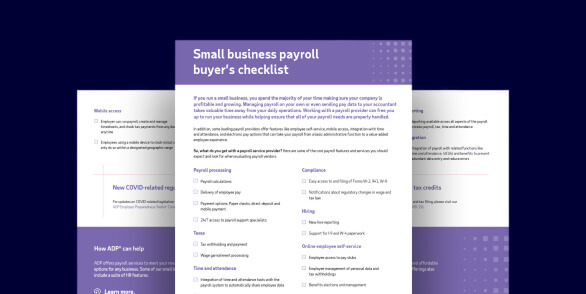Payroll records are the combined documents pertaining to payroll that businesses must maintain for each individual that they employ. This includes pay rates, total compensation, tax deductions, hours worked, benefit contributions and more.
What documents make up payroll records?
The documents commonly need for payroll recordkeeping include but are not limited to:
- Employee personal information
Includes names, addresses, telephone numbers, e-mail addresses, direct deposit information, emergency contact information, date of birth, occupation, Social Security numbers and benefit plan enrollment information - Employment information
Includes offer letters, employment eligibility data, full time or part time status, background checks, references, signed company policies, evaluations, and termination information - Timesheets
Includes regular hours, overtime hours and hours worked per day, workweek and pay period - Pay information
Includes rate of pay, workweek beginning and ending dates, total hours worked, payment agreement or the employee’s pay basis (e.g., hourly, salary, commission, etc.), and the employee’s classification (e.g., exempt or nonexempt) - Tax documents
Includes federal, state and local jurisdiction tax forms and tax return copies, such as the IRS Form W-4, Employee’s Withholding Certificate or state tax withholding certificates - Deduction information
Includes benefit deductions, wage garnishment orders, union dues and deferred compensation information - Paid and unpaid leave records
Includes paid time off (PTO) and vacation time balances and associated payment amounts, as well as records for other types of leave, such as Family Medical Leave Act (FMLA), state paid leave programs and paid sick leave - Direct deposit information
Includes financial institution names, account numbers and routing numbers - Reimbursement forms
Includes expense reports for work travel, office supplies, etc. - Pay records
Includes payroll registers and other documentation with payroll details, such as pay period beginning and ending dates, payment date, and type of wage payments (i.e., regular, overtime, tip credit, bonuses, commission, paid leave time, etc.)
Where should payroll documents be kept?
Most organizations today store their payroll documents digitally, either in the cloud or using external hard drives. Of the two, cloud storage is generally more secure, which is why many payroll service providers use it. However, recordkeeping is ultimately the responsibility of employers. They must download the appropriate reports and documents from the service provider and retain them for the length of time required.
How to keep payroll records (and best practices for doing so)
Paper records are an option for small businesses, though employers may quickly run out of space and need a customized storage solution. Those who prefer to keep hard copies also need a physical means of safe storage, such as a fireproof lock box.
Midsized and large businesses, on the other hand, generally require automated or semi-automated, digital recordkeeping. They use payroll software, which provides the payroll-related reports and documentation necessary to support compliance, and updates records each time payroll is run.
Regardless of the method chosen, businesses must ensure they retain their payroll records for the specific length of time mandated by federal, state and local laws. Once that time has lapsed, documents pertaining to employees who have left the business may be destroyed to prevent the misuse of confidential information.
It’s also best practice to be aware of all state-specific requirements. Some states, for instance, require records to be maintained in a certain manner at a specific location.

Keeping payroll records for tax reasons
In the event of an IRS audit, having four years’ worth of payroll tax records* readily available can help the process go smoothly. Well-maintained records also make it easier for employers to prepare and file tax returns with government agencies. Those that use payroll software with self-service features improve the employee experience, too. Through the system, they can access their tax and pay information and download forms on their own.
Keeping payroll records for legal reasons
Both federal and state laws enforce payroll recordkeeping.* Employers must abide by the laws that apply to their business and ensure that they maintain records for the retention periods required. Some examples of records that must be retained in accordance with federal law are:
- Fair Labor Standards Act (FLSA)
Under the FLSA, payroll records for non-exempt workers must be retained for at least three years and timesheets or other documents that show how wages were calculated must be retained for at least two years. - The Equal Employment Opportunity Commission (EEOC)
To comply with the EEOC, employers have to keep personnel and employment records for one year. The records of any employee involuntarily terminated must also be kept for one year, starting from the date of termination. - Employee Retirement Income Security Act (ERISA)
Section 107 of ERISA requires employers to save some documents related to retirement savings plans for at least six years, though other records may need to be kept much longer.
Other reasons to keep payroll records
Payroll records contain valuable data about wages and taxes that can help businesses create better budgets and manage labor expenses. They’re also useful to employees who may need payroll documents to verify proof of employment for various reasons, such as to rent an apartment or apply for a loan.
Payroll file checklist
A checklist can help ensure that payroll records are complete. Here is some of the information generally found in payroll files:
- Employee name and address
- Employee date of birth and Social Security number
- Employee occupation
- Offer letter
- Pay authorization
- Form I-9, Employment Eligibility Verification
- Form W-2, Wage and Tax Statements
- Form W-4, Employee’s Withholding Certificate
- State and local jurisdiction tax withholding certificates
- Payroll deductions
- Direct deposit authorization form
- Salaried time accounting forms
- Timesheets or time clock records
- Time off and attendance records
- Expense reimbursement requests and receipts
- Garnishment orders and records
- Any authorization for release of private information
- Documentation and justification for pay raises
- Bonus, profit sharing or award paperwork
Frequently asked questions about payroll records
What is meant by payroll records?
Payroll records are the combined documents pertaining to payroll that employers must maintain for each individual employee at their workplace.
What information is included on a payroll record?
For each employee, payroll records commonly consist of:
- Personal information (name, address, etc.)
- Employment information (offer letters, evaluations, etc.)
- Exemption status and rate of pay
- Timesheets (if non-exempt)
- Payment records
- Tax withholding and benefit deductions
- Garnishment withholding orders
- PTO, vacation, paid sick or other leave balances
- Banking information for direct deposit
- Work-related expense reports
What payroll records must be kept?
Employers must keep the specific payroll and tax records required by all federal, state and local laws. This includes hours worked, rates of pay, total payments, pay period dates and much more. If in doubt about the requirements, employers should seek professional assistance.
How do I create a payroll record?
Payroll records can be created manually, though it’s usually more efficient and accurate to use payroll management software, which has built-in standard reports that employers can use for their recordkeeping purposes.
Do I need payroll for one employee?
Yes, even employers who only have a single employee must complete payroll and retain the records needed for compliance.
* Some state and local jurisdictions may require employers to maintain records for longer retention periods than the federal government.
This guide is intended to be used as a starting point in analyzing an employer’s payroll obligations and is not a comprehensive resource of requirements. It offers practical information concerning the subject matter and is provided with the understanding that ADP is not rendering legal or tax advice or other professional services.




